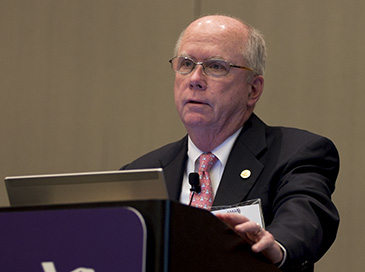Electronic health records (EHR) hold a lot of promise, but they have a long way to go. Members of the medical profession identified some of the key issues that need to be addressed before the technology can widely benefit practice efficiency and patient care during a session Saturday at the 2014 AMA Annual Meeting.
“Are the majority of physicians in the United States unhappy? I think the answer is no,” said Jay Crosson, MD (pictured left), who heads up the AMA’s Professional Satisfaction and Practice Sustainability initiative. “The majority of physicians will say that they are satisfied with their profession. But if you ask detailed questions, virtually every physician will give you a list of things that should be better.”
A large portion of that detailed list centers on issues with EHRs.
“The vast majority of physicians recognized that EHRs were an improvement over paper records,” Dr. Crosson said, citing a recent AMA study conducted by the RAND Corporation.
Some of the positive factors physicians pointed to were not having to worry about losing charts, better access to data that could help improve quality and improved communication within individual practices.
“But positive findings were overwhelmed by negative ones,” Dr. Crosson said. He rattled off a list of the most common complaints, including:
- The amount of time required to input data takes too much time away from patient care.
- EHR systems aren’t matched to the work flow of the practice, causing major disruptions.
- The technology interferes with face-to-face interaction with patients.
- Systems aren’t able to exchange information between practices.
- The tremendous cost places financial strain on practices.
A panel of physicians from different practice sizes and career stages discussed some of the issues they hope soon will be addressed.
“Interoperable systems [are] the lynchpin of this whole system,” said David Bronson, MD, a general internist at the Cleveland Clinic. “Until that happens, we’ve invested a whole lot of money into a system that has not provided return on investment.”
Ryan Ribeira, MD, who served this year as the medical student member of the AMA Board of Trustees, explained that even the next generation of physicians has a detailed list of changes they’d like to see.
“I’ve spoken to many, many medical students who say they would never consider a residency program that didn’t have an EHR system,” Dr. Ribeira said. But as native users of technology, “students may be more sensitive to the [cumbersome] interface of EHRs because they are accustomed to ease of use.”
Steven Stack, MD, an emergency physician and AMA president-elect , said that a special AMA advisory committee of physician experts is working on a report that identifies the top recommendations for improving the usability of EHRs and anticipates the big problems that will arise in the future.
“We are working over the next six to 12 months with software vendors,” Dr. Stack said. “And we have ongoing dialogue with how the industry can be responsive to our concerns.”
The AMA also continues to press the federal government for important changes to the burdensome EHR meaningful use program.
“They foisted this massive program on all of health care … and [the technology] wasn’t ready,” Dr. Stack said. “It still isn’t ready. And it’s going to take longer to fix it than it did to create it.”
Another panelist, David Welsh, MD, a general surgeon in rural southeast Indiana, said making these improvements all comes down to prioritizing patients.
“If we can make EHRs work,” Dr. Welsh said, “we can get back to putting patients first.”




